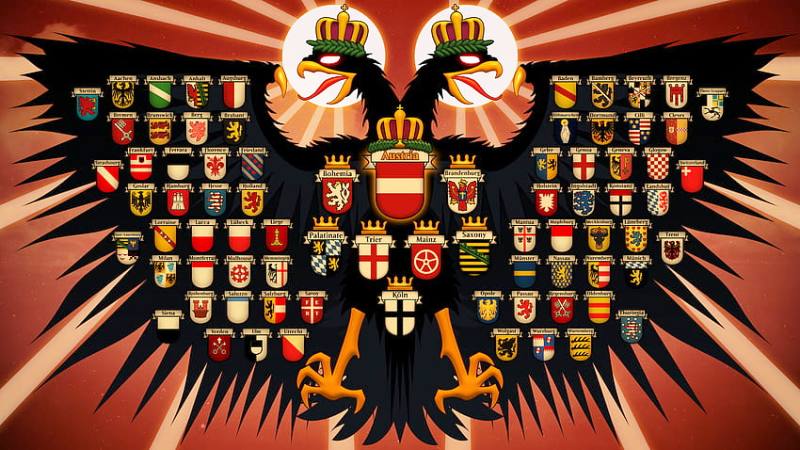The vast political organization known as the Holy Roman Empire, which lasted from 800 AD to 1806 AD, has long captivated historians, students, and enthusiasts. So let’s check out everything about the Holy Roman Empire Map article. The Holy Roman Empire Map is a crucial tool for comprehending its size, complexity, and evolution. This Holy Roman Empire Map article delves deeply into the purpose, significance, and characteristics of this Holy Roman Empire Map.
One of the most intricate designs in the vast tapestry of European history, which is filled with conquests, dynasties, and revolutions, can be found in the Holy Roman Empire. Maps, which are artefacts that stand at the nexus of art, geography, and history, are the best way to delve into this grand political entity’s history, which spans more than a thousand years.
With their intricate details and changing contours, the Holy Roman Empire Map act as windows into a bygone era of emperors and principalities. This Holy Roman Empire Map article takes you on a tour of these cartographic wonders and provides you with information about their creation, significance, and enduring impact. Now let’s get to know more about this Holy Roman Empire Map guide.
1. Introduction to the Holy Roman Empire
Origins and Background:
- The Holy Roman Empire was established in 800 AD when Pope Leo III crowned Charlemagne, the King of the Franks, as the Holy Roman Emperor.
- The empire was not a homogenous state but rather a collection of territories in Central Europe.
Geographical Spread:
- At its zenith, the empire comprised present-day Germany, Austria, Switzerland, the Czech Republic, the Netherlands, Belgium, parts of Italy, and more.
2. Mapping the Empire: An Overview
A Holy Roman Empire map is more than just a depiction of its borders. It provides a snapshot of the era’s political, social, and cultural dynamics.
Evolution of the Maps:
- Early maps, from around the 10th and 11th centuries, were simple and had limited details.
- The Renaissance period witnessed a significant improvement in map-making techniques. This period produced some of the most detailed and artistically rich maps of the Holy Roman Empire.
- Modern-day maps, constructed using digital tools and ancient manuscripts, offer a blend of accuracy and aesthetics.
3. Significance of Holy Roman Empire Map
Both historians and the general public must comprehend the significance of the Holy Roman Empire Map:
- Historical Context: They provide insights into territorial disputes, political dynamics, and important trade routes of the period.
- Educational Tool: They are invaluable in classrooms for teaching medieval European history.
- Cultural Insight: Maps often incorporated elements of popular culture, religion, and societal norms, offering a deep dive into the life of the people during the Holy Roman Empire era.
4. Key Features of the Holy Roman Empire Map
A typical Holy Roman Empire map would have the following characteristics:
- Territorial Boundaries: These were often marked distinctly, showcasing the empire’s expanse and its principalities, kingdoms, and regions.
- Trade Routes: Many maps highlight the main trade routes, which were vital for commerce and communication.
- Key Cities: Important cities like Rome, Vienna, and Prague were prominently marked.
- Rivers and Mountains: Geographical features such as the Alps, the Rhine, and the Danube were frequently depicted, demonstrating their significance in the empire’s topography and commerce.
- Annotations: Earlier maps, especially, contained annotations in Latin, offering insights into the region or a particular event.
5. Notable Holy Roman Empire Map Editions
There have been several notable map editions throughout time:
- Tabula Rogeriana (1154): An early world map by the Arab geographer Al-Idrisi, which includes parts of the Holy Roman Empire.
- Ptolemaic Maps (15th Century): Renaissance editions of Claudius Ptolemy’s Geographia, which depicted the Holy Roman Empire with remarkable accuracy for its time.
- Maps by Hartmann Schedel (1493): As part of the Nuremberg Chronicle, these Holy Roman Empire Map are historically significant and artistically captivating.
6. The Complexity and Fragmentation of the Holy Roman Empire
The intricate patchwork of territories is obvious when looking at the Holy Roman Empire Map. This intricate mosaic was a representation of the nature of the empire, not just the outcome of chance events.
Reasons for Fragmentation:
- Imperial Electors: These were a select group of nobles with the privilege of electing the Emperor. Their territories were particularly significant and prominently depicted.
- Semi-Autonomous Regions: Many regions and cities within the empire had varying degrees of autonomy, making the empire more of a confederation than a centralized state.
- Religious Disparities: With the Protestant Reformation, the empire saw a rise in religious states or territories aligning themselves with either Catholicism or various Protestant denominations. Holy Roman Empire Map from the 16th century onwards often indicated these religious allegiances.
7. The Artistry Behind the Holy Roman Empire Map
Holy Roman Empire map were frequently works of art beyond their utility. Mapmakers, or cartographers, were respected members of the scientific and artistic communities.
Artistic Elements Often Found in the Maps:
- Illuminations: Especially in the earlier maps, it was common to find borders and capital cities illuminated with gold or vibrant colours.
- Sea Monsters and Ships: In maps that featured seas or large rivers, illustrators often added fantastical sea creatures or intricately detailed ships.
- Coats of Arms: To indicate the rulers of particular territories, many maps showcased the relevant coat of arms or heraldic symbol.
- Landscape Elements: Beyond the geographical necessities, artists would often add forests, animals, or even mythical creatures to empty spaces, providing the map with a rich, detailed look.
8. The Legacy of Holy Roman Empire Map in Modern Cartography
The foundation for modern map-making was laid by the principles and practices of cartography during the Holy Roman Empire. This is how:
- Precision and Accuracy: The meticulous attention to detail, especially in the maps from the Renaissance period onwards, set the standard for accuracy in cartography.
- Aesthetic Appeal: Cartographers today still appreciate the blend of functionality and artistry from these historical maps, often replicating such styles in thematic or speciality maps.
- Cultural Documentation: Modern cartography has learned the importance of capturing cultural nuances from the Holy Roman Empire map, ensuring that maps are not just geographical tools but also historical documents.
9. The Intersection of Technology and Holy Roman Empire Map
Technology has shed new light on the intricate Holy Roman Empire Map with the advent of the digital age.
Digital Preservation and Accessibility:
- Digital Scanning: Many of the Holy Roman Empire Map, stored in museums or private collections, have undergone high-resolution digital scanning. This ensures their preservation for future generations and protects the originals from wear and tear.
- Online Libraries: Platforms like Europeana, the David Rumsey Historical Map Collection, and various university archives have made these maps accessible to a global audience at the click of a button.
- Interactive Maps: Advanced programming and web tools have transformed static maps into interactive experiences. Users can now zoom into specific regions, get detailed information, and even view overlays of modern boundaries for better context.
10. The Modern Reverberations of the Holy Roman Empire’s Geography
The intricate territorial divisions of the Holy Roman Empire still have an impact on the political and cultural landscapes of today’s Europe.
- Linguistic Heritage: Areas within the former empire still maintain dialects and languages that trace back to those historical times, a feature often indicated on the older maps.
- Cultural Festivals and Traditions: Many regions, especially in Germany and Austria, celebrate festivals that originate from their status within the old empire. These traditions often correlate with the maps showcasing the diverse regions of the empire.
- Political Boundaries: Modern countries like Germany, Austria, and the Czech Republic have states or provinces that reflect, to some extent, the principalities and territories of the Holy Roman Empire.
11. The Enduring Fascination: Why We’re Still Drawn to These Maps
Even though the Holy Roman Empire fell apart more than 200 years ago, its maps continue to captivate people. But why are we so drawn to these complex works of history and art?
- Tales of Power and Intrigue: Each boundary, territory, and marked city has a story – of powerful rulers, significant battles, or political machinations.
- Artistic Brilliance: The sheer craftsmanship, from detailed coastlines to illuminated capitals, is a testament to the artistry of yesteryears, making these maps a collector’s delight.
- Quest for Understanding: For historians, geographers, and enthusiasts, these maps are essential tools to understand the shaping of modern Europe.
12. The Role of the Holy Roman Empire Map in Contemporary Scholarship
The Holy Roman Empire Map are of enormous value to academia, particularly in fields like history, geography, and political science. Here are some ways that these Holy Roman Empire Map are influencing modern scholarship:
- Comparative Studies: Scholars often juxtapose the Holy Roman Empire map with those of other empires or regions, aiding in comparative studies on empire-building, governance, and territorial strategies.
- Socio-Cultural Analyses: The details on these maps often lead to studies of societal structures, urbanization patterns, and cultural hubs, helping in understanding the societal fabric of that era.
- Geopolitical Courses: Many universities use these maps in their courses to teach about the evolution of political boundaries, sovereignty, and international relations.
13. Replicating the Past: The Revival of Map Artistry Inspired by the Holy Roman Empire
While providing tools for accuracy and precision, the digital age has also seen a resurgence in the artistic elements of map-making. Holy Roman Empire map artistic quality has grown to be a significant source of inspiration:
- Handcrafted Map Art: Artisans and artists are reverting to hand-drawn map designs, often imitating the intricate details, illuminations, and calligraphy found in the Holy Roman Empire Map.
- Digital Art Platforms: Digital artists are combining the aesthetics of old maps with modern design tools to create wallpapers, prints, and interactive digital artworks.
- Merchandise: The unique designs are often replicated on merchandise, from posters and journals to apparel and home décor, celebrating the fusion of history and art.
14. The Map Beyond the Empire: Influence on Mapping Other Historical Empires
The method and level of detail used in the Holy Roman Empire’s maps have become standards for other historical empires and kingdoms to follow:
- Detailing Trade and Migration Routes: Inspired by the clear indications of trade routes on the Holy Roman Empire map, cartographers began to adopt similar detailed representations for empires like the Ottomans and the Mongols.
- Highlighting Cultural Centers: Just as key cities were depicted prominently in the Holy Roman Empire map, the Holy Roman Empire Map like the Byzantine or Persian highlighted their centres of art, education, and culture.
- The layering of Political Power: The division of territories based on principalities, electors, and religious divides in the Holy Roman Empire map became a template for illustrating power dynamics in other empires.
Final Verdict
So this is all about the Holy Roman Empire Map article guide. The Holy Roman Empire Map stand as an imposing beacon of our effort to record, comprehend, and appreciate our past as the world continues to chart new lands and explore uncharted regions. They set a challenge for today’s cartographers to weave the tapestry of human civilization, one city, one river, and one boundary at a time, rather than simply map the world.
As we come to the end of our investigation, it becomes obvious that the Holy Roman Empire map is much more than just old parchment with ink. They serve as mirrors, illuminating a glorious period in European history. They encompass stories of bravery, faith, aspiration, and artistic talent. The difficulty and opportunity lie in utilizing contemporary tools to ensure that these maps and the stories they contain endure as the digital age advances. Hope you like this Holy Roman Empire Map from here now.
The Holy Roman Empire map requires a journey through time to be understood fully. The political machinations, cultural changes, religious movements, and artistic development documented in these artefacts span centuries. They provide priceless insights into the roots of European civilization, whether they are seen in a museum, studied in a classroom, or recreated in a contemporary setting.
The fundamental principles of mapping remain rooted in the time-tested procedures perfected during the eras of emperors and empires, even as we continue to map our planet in novel ways, such as with digital maps and virtual reality. Hope you enjoy checking this type of Holy Roman Empire Map content.
The Holy Roman Empire’s maps are more than just historical artefacts, to sum up. They provide a visual journey through a world that had a significant impact on the development of European history. They are windows into a bygone era. They continue to enthral and inform as resources for learning, research, and appreciation. If you enjoy reading the Holy Roman Empire Map then please do share the Holy Roman Empire Map with others as well.
People Also Ask (FAQs):
What exactly was the Holy Roman Empire?
- The Holy Roman Empire was a multi-ethnic complex of territories in Central Europe that existed from 800 to 1806. Its vast expanse and dynamic political nature made it a key player in European history.
Why is the Holy Roman Empire Map important for historical studies?
- These maps provide a visual representation of the territorial evolutions, political shifts, and cultural boundaries over a millennium. They’re crucial tools for understanding medieval European geopolitics.
How accurate are the oldest Holy Roman Empire Map?
- While early maps, especially from the 10th and 11th centuries, were more symbolic and lacked the precise accuracy of modern cartography, they still provide valuable insights into the perceptions and priorities of the period.
Did the Holy Roman Empire have a constant boundary?
- No, the boundaries and territories within the Holy Roman Empire evolved significantly over its existence, reflecting its political, military, and cultural changes.
How does the Holy Roman Empire map compare to those of other contemporary empires?
- The Holy Roman Empire Map, with its intricate details and evolving nature, are unique given the empire’s structure. However, like other empire maps from the same era, they often combined artistic flourishes with functional details.
Are there digital versions of these maps available for study?
- Yes, many of the Holy Roman Empire’s maps have been digitized and are available through online archives, museums, and university databases. These digital versions allow for interactive exploration and detailed study.
How do modern European borders reflect the territories of the Holy Roman Empire?
- While modern European borders have been influenced by various geopolitical events after the empire’s dissolution, some regions, especially in Central Europe, still echo the territorial divisions of the Holy Roman Empire.
Who were the most notable cartographers of the Holy Roman Empire era?
- The era witnessed several renowned cartographers, including Johannes Kepler, Gerhard Mercator, and Sebastian Münster. Their works have been instrumental in shaping modern cartography.
How did the Protestant Reformation impact the Holy Roman Empire Map?
- The Protestant Reformation led to significant religious divisions within the empire. Consequently, maps post-Reformation often illustrated territories based on religious allegiances – marking Protestant and Catholic regions distinctly.
Were there specific symbols or icons unique to the Holy Roman Empire map?
- Yes, the Holy Roman Empire map often incorporated unique symbols, such as imperial eagles, crowns, and sometimes even illustrations of notable emperors, reflecting the empire’s grandeur and significance.
How were cities of significance depicted differently on these maps?
- Major cities, like Vienna, Prague, and Nuremberg, were often highlighted with intricate details, larger icons, or even gold illuminations, signifying their prominence in the empire.
Why did the Holy Roman Empire not unify into a singular nation-state like France or England?
- The empire’s complex structure, with its electors, independent bishoprics, and numerous semi-autonomous regions, coupled with external pressures and internal rivalries, prevented it from consolidating into a singular nation-state.
How did wars and conflicts within the empire influence its cartographic representation?
- Wars often led to territorial shifts. Consequently, maps would be redrawn to reflect these changes. Moreover, regions of strategic importance during wars might be depicted with greater detail or prominence.
Are there any exhibitions or museums dedicated to the Holy Roman Empire Map?
- Several museums, especially in Germany and Austria, occasionally host exhibitions focusing on the empire’s cartography. Libraries, such as the British Library or the Austrian National Library, also house some of these precious maps in their collections.
Explore this Holy Roman Empire Map article in greater detail to discover the solutions to these issues and to immerse yourself in the fascinating field of Holy Roman Empire cartography. Explore these fascinating issues in-depth in our Holy Roman Empire Map article to learn more about the fascinating legacy of mapmaking left by the Holy Roman Empire.

















